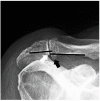Bony Regrowth and New Spur Formation as Possible Causes of Failed Distal Clavicle Excision-Mid-Term Outcomes after Revision Surgery in a Matched-Pair Analysis
- PMID: 37623471
- PMCID: PMC10455436
- DOI: 10.3390/jpm13081221
Bony Regrowth and New Spur Formation as Possible Causes of Failed Distal Clavicle Excision-Mid-Term Outcomes after Revision Surgery in a Matched-Pair Analysis
Abstract
Background: Despite high rates of successful outcomes after open and arthroscopic distal clavicle excision (DCE) for symptomatic acromioclavicular joint (ACJ) degeneration, some patients present with persistent symptoms and disabilities after surgical intervention. This study aims to compare radiological, functional, and subjective outcomes of open revision surgery after failed arthroscopic DCE to primary successful arthroscopic DCE.
Methods: In this retrospective case-control study, 10 patients who underwent open DCE revision were age- and gender-matched with 10 patients who did not require revision surgery after DCE. Radiographic evaluation included presence of acromioclavicular spurs and acromioclavicular joint distance. Functional and subjective outcomes were assessed using the CS, SSV, SST, VAS for pain, patient's satisfaction, ASES and quick DASH score.
Results: At the latest postoperative follow-up (case: 57.3 ± 19.2 months; control: 63.5 ± 16.3 months), spur formation was detected in twice as many cases in the revision group, while acromioclavicular distance showed no significant difference. However, a significant bony regrowth was noticed in the revision group between revision surgery and latest follow-up, with a decrease of the acromioclavicular distance from 9.2 ± 1.6 mm to 5.9 ± 4.6 mm (p = 0.026) and a development of new spur formations in 30% of cases. There were no significant differences in overall CS between the revision and control group (p = 0.174) at final follow-up, but the control group scored significantly higher in the CS subgroups pain (p = 0.012) and internal rotation (p = 0.016). Mean SSV was significantly lower in the revision (65.5 ± 22.3%) compared to the control group (85.9 ± 16.4%; p = 0.031).
Conclusions: Bony regrowth at the distal clavicle presenting as postoperative AC-distance narrowing and new spur formation was observed more distinctly in the revision group. Despite a slight increase in postoperative outcomes after revision surgery, subjective satisfaction and recalcitrant pain remain a concern.
Level of evidence: Therapeutic Level III, retrospective case-control study.
Keywords: AC-joint; acromio-clavicular; arthroscopy; revision.
Conflict of interest statement
W.A., R.C.O. and P.R.H. receive personal fees from Arthrex, Inc. The company had no influence on the study design, data collection, interpretation of the results, or the final manuscript. The remaining authors (M.E., P.S., W.M., L.A., B.S., B.L. and L.P.) declare that they do not have any conflict of interest pertinent to this study.
Figures



References
LinkOut - more resources
Full Text Sources
Research Materials

